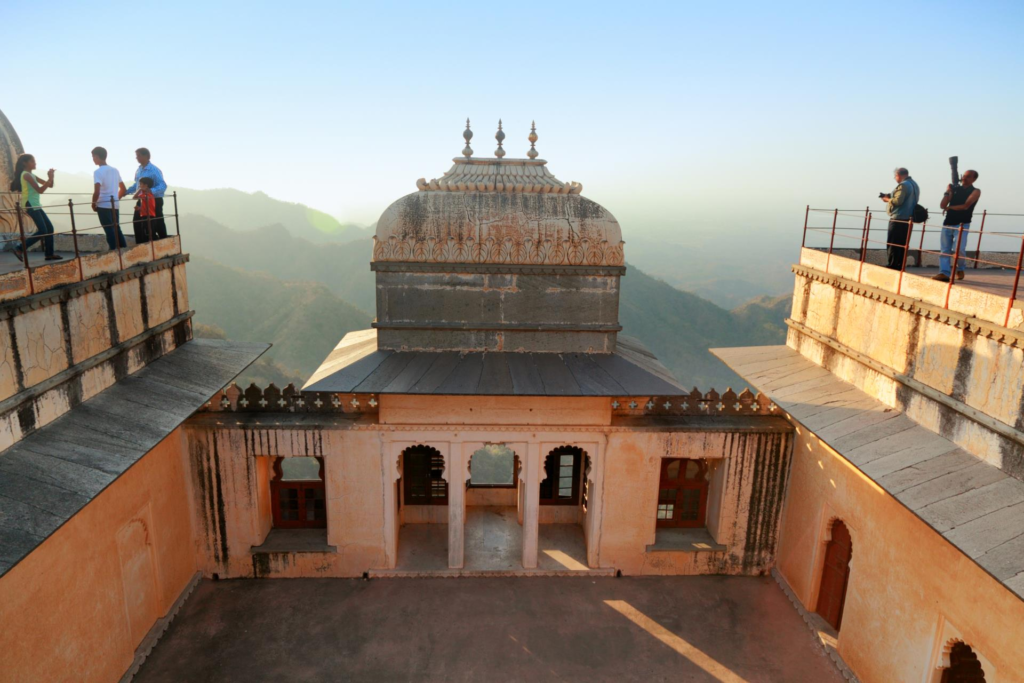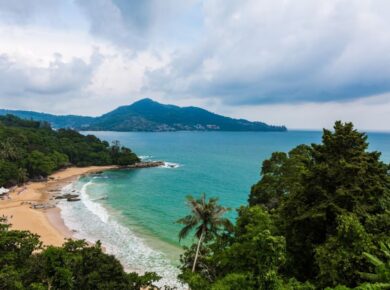Kumbhalgarh: Rajasthan’s Majestic Hilltop Fortress
The Marwari greeting “Padharo Mhare Desh,” which translates to “Welcome to my Land,” serves as both a greeting to guests from around the world and a symbol of the hospitality of the Rajasthani people. The expression perfectly describes Rajasthanis, who take pride in showcasing their rich cultural heritage to visitors and are hospitable and welcoming by nature.
Known as the cultural capital of India, Rajasthan upholds the essence of the royal grandeur of kings and Rajputs and the folk cultures of many communities. The state of Rajasthan is not only famous for its rich history and majestic palaces but also for its vibrant festivals and traditional art forms.
Kumbhalgarh
Kumbhalgarh, located in the Rajsamand district of Rajasthan, India is known for its majestic fort. In Kumbhalgarh, there are quite a few attractions to see, ranging from dense wildlife sanctuaries to temples built centuries ago.
The picturesque town of Kumbhalgarh is home to the renowned Kumbhalgarh Fort, a World Heritage Site that is surrounded by the majestic Aravalli hills. If you plan a trip to Rajasthan, Kumbhalgarh is a must-see destination that will captivate you with its beauty and charm. The community is renowned for having a vibrant culture and traditions.
Kumbhalgarh Wildlife Sanctuary :
The Rajsamand District of Rajasthan State in western India is home to the Kumbhalgarh Wildlife Sanctuary. The Kumbhalgarh Wildlife Sanctuary is named after the historic fort of Kumbhalgarh. The wildlife sanctuary is spread across four Aravalli mountain ranges: the Kumbhalgarh, Sadri, Desuri, and Bokhada ranges. Twenty-two villages are situated within the sanctuary.
The sanctuary’s current location was once a royal hunting ground in 1971 before being transformed into what it is today. The main source of water here is the River Banas.

How do I get there?
The sanctuary is located at a distance of 3 km from Kumbhalgarh Fort, 51 km from Nathdwara, 48 km from Rajsamand, and 98 km from Udaipur. One can hire cabs from these destinations to reach Kumbhalgarh Wildlife Sanctuary.
Where can I stay near the Kumbhalgarh Sanctuary?
There are stays near Kumbhalgarh Fort. Thandi Beri, Ranakpur, Sumer, Sadri, and Roopanmata are villages/towns nearby.
Here are some recommendations for how to visit Rajasthan’s Kumbhalgarh Sanctuary:
Jeep Safari: The most well-liked Jeep safari in the sanctuary is from Kumbhalgarh to Thandi Beri, a 15km route. The journey to Thandi Beri and back takes about 3.5 hours.
Horseback riding: The horseback riding routes include Kumbhalgarh to Ghanerao via Thandi Beri, Thandi Beri to Sumer, Ranakpur to Thandi Beri, and Roopanmata to Ranakpur.
Trekking: Trekking expeditions are perfect for the sanctuary’s hilly terrain. The Tirthankar Natural Trail in the sanctuary is a well-liked route. The 3.7-kilometer trail is an ode to the Jain Tirthankaras as well as an example of an ideal Aravalli ecosystem. On the trail’s sides, various plants from which Jain Tirthankaras attained enlightenment are planted
Other popular trails are Kumbhalgarh to Thandi Beri (14 km), Roopnagar to Sumer (98 km), Ranakpur to Ranakpur (15 km), Ranakpur to Kumbhalgarh (25 km), Malgarh to Magga (8 km), Roopanmata to Ranakpur (30 km) and Ranakpur to Thandi Beri (15 km).
Wildlife exploration:
The Indian wolf, Indian leopard, sloth bear, striped hyena, golden jackal, jungle cat, sambhar, nilgai, chausingha (four-horned antelope), chinkara (Indian gazelle), and Indian hare all reside in the Kumbhalgarh Wildlife Sanctuary. The dominant predator in the sanctuary is the leopard.
The 40-strong wolf pack that inhabits the Kumbhalgarh wildlife sanctuary is renowned and uncommon elsewhere. The fact that wolf breeding is successfully carried out here makes the reserve a special place.
Kumbhalgarh Wildlife Sanctuary also houses an excellent variety of birds. Peacocks, Doves, Grey Jungle Fowl, White Breasted Kingfishers, Parakeets, Red Spur Owls, Bulbul, and Golden Oriole are among the animals you can see. The sanctuary is home to more than 200 different bird species.
The sanctuary consists of several types of herbal flora, including Dhok, Salar, Khair, and Churel. These herbal florae provide a diverse habitat for the birds and other wildlife in the sanctuary.
There are also numerous tribal members of the Garasia and Bhils groups living in these locations. Visitors come to the sanctuary from all over because of its natural beauty. The monsoon season is the ideal time to visit the sanctuary to experience the lush greenery and pleasant breeze.
Kumbhalgarh Fort: The Birthplace of legendary King Maharana Pratap in Mewar
Maharana Pratap, born in 1540, was a valiant Rajput warrior and the ruler of Mewar. Known for his bravery and unwavering spirit, Maharana Pratap is considered a legendary figure in Indian history.
Kumbhalgarh, the second-most significant fort in the Mewar region after Chittorgarh, is situated 84 kilometers north of Udaipur in a remote area. Kumbhalgarh Fort was designated a World Heritage Site by UNESCO in 2013.
There are numerous palaces, over 70 temples, and gardens in this white marble-built city. The Kumbha Palace, the Badal Mahal (Palace of Clouds), the Neelkanth Mahadev Temple, and the Vedi Temple are just a few of the fort’s top attractions, showcasing the architectural brilliance of the Rajput era. The Kumbhalgarh Fort Complex is undoubtedly one of the biggest fort complexes in the entire world.
The fort was built in the 15th century by Rana Kumbha and is renowned for its massive walls that stretch over 36 kilometers, making it one of the longest fortifications in the world. There are Seven gates called pol :
Ram pol – the main entrance of the gate
Arait pol
Hanuman pol
Hulla pol
Bhairon pol
Nimboo pol
Paghara pol
Regular buses or a taxi can be easily obtained from the city of Udaipur to the Kumbhalgarh Fort. Udaipur has the closest airport (98 kilometers).
It is of immense sentimental significance for the people, being the birthplace of Mewar’s legendary king, Maharana Pratap. The fort holds great historical and cultural significance, as it has witnessed numerous battles throughout its history. Today, the fort attracts tourists from all over the world who come to admire its grandeur and learn about its rich heritage.
Badal Mahal

Maharana Fateh Singh, who was well-known for his appreciation of the arts and architecture, built the Badal Mahal in the latter half of the 19th century. The palace was initially intended to be the royal family’s summer retreat.
The Hindi name “Badal Mahal,” which means “Palace of Clouds,” was given to the structure. Because of the palace’s high elevation and the pleasant breeze that blows through it, it was given this name. Badal Mahal is the highest point located at the top of the Kumbhalgarh Fort.
Badal Mahal offers breathtaking panoramic views of the surrounding landscape, making it a popular attraction for tourists. It showcases exquisite Rajput architecture, with intricately carved pillars, graceful jharokhas (balconies), and beautiful paintings adorning its walls with pastel-colored murals, representing the period of the 19th century. The spacious design of the palace, which was erected on top of a hill, lets in plenty of natural light and promotes good ventilation.
Badal Mahal is a two-story palace. The whole building of the palace is divided into two interconnected mahals called the Mardana Mahal and the Zanana Mahal. Place rooms have turquoise, green, and white color schemes on their walls.
How do I get to Kumbhalgarh’s Badal Mahal?
By Road: Badal Mahal is located 100 km from Udaipur in the Rajsamand District of Kumbhalgarh. It’s simple to take a bus or a taxi to get here.
By Rail: The closest rail stations, Falna and Rani, provide quick access to major cities like Delhi, Agra, Mumbai, Chennai, Bikaner, Jodhpur, Jaipur, and Ahmedabad.
Kumbhalgarh Festival :
The Kumbhalgarh festival is a 3-day annual event that takes place in December and is a celebration of Indian culture that perfectly combines art, culture, and entertainment. One such celebration of Maharana Kumbh’s contributions to art and culture is the yearly Kumbhalgarh festival.
The festival celebrates Rajasthan’s culture and heritage with some of the best performances by local artists, traditional folk dances, and music set against the backdrop of the fort at Kumbhalgarh. Yellow lighting is used during the festival to give the fort a golden appearance.
There are two parts to the festival. Locals hold exhibitions during the day where they showcase local specialties like ethnic clothing, jewelry, handicrafts, local cuisine, and so on. It comes alive with music, dance, and light in the evening.
One is able to witness classical and folk music and dance performances such as Sufi (a form of music and dance that transcends your senses and brings you closer to spirituality), Kalbelia (a desert tribe of snake charmers whose folk dance performances feature the women wearing all black attire dancing, while the men play music on traditional instruments), Bhavai (a type of folk dance in which both men and women dance while holding earthen pots on their heads), Chari (a Rajasthani folk dance in which one holds a flaming pot on their head), Ghoomar (a dance in which women swirl while wearing flared ghagras), and others. Kathputli, a traditional Rajasthani string puppet performance, is a captivating art form that has been passed down through generations. Skilled puppeteers manipulate the strings of the wooden and cloth puppets, bringing them to life. The performances frequently depict historical occasions, cultural traditions, and old folktales, luring viewers into a magical and fascinating world.
There are some entertaining competitions held between locals and visitors, including musical chairs, tug-of-war, and pagadi bandho (tying the turban). Additionally, visitors can see the historical and well-known puppet show.

You can devour the mouth-wateringly delicious authentic Rajasthani cuisine, including dal baati churma, gatte ki sabzi, Pyaaz ki kachori (Onion kachori), ker sangri, Ghevar, and Laal Maas.
This event has been carefully curated and nurtured by the state tourism department to showcase the rich artistic traditions of Rajasthan. The state’s warm and welcoming nature, coupled with its rich cultural heritage, makes it a must-visit destination for travelers from around the world.
Looking to travel and experience the culture, food, and nature, or soak in adventure, explore curated Journeys with UnCrushedLeaves now.




